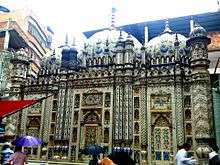Qassabtuly Mosque
The Qassabtuly Mosque is one of the most ornate mosques in Old Dhaka, Bangladesh. It's gloriously inscribed decorations are delicate and one of a kind.[1][2][3]
| Qassabtuly Mosque | |
|---|---|
কাস্বাবটুলি মসজিদ | |
 | |
| Religion | |
| Affiliation | Islam |
| Branch/tradition | Sunni |
| Year consecrated | 1919 |
| Status | active |
| Location | |
| Location | |
| Architecture | |
| Architect(s) | Abdul Bari, Qamruddin Sardar |
| Type | Mosque |
| Style | Bengali architecture |
| Date established | 1919 |
| Groundbreaking | 1919 |
| Completed | 1919 |
The foundation of the Qassabtuly Jam-e-Masjid (Hijri 1338), laid by Abdul Bari Bepari and others and situated in old town Dhaka in Bangladesh, was built in the year of 1919.[4] It has recently acquired the name "Koshaituly Jam-e-Masjid" referring to "koshais" (butchers) who used to dwell at the old town.
Preview
The mosque was built by Qamruddin Sardar.
The construction of the mosque stretched to the year of 1945 and was renovated in the year of 1971. The building of this mosque had a remarkable impact on the Muslims of Bengal, as it introduced pre-mughal art and architecture when it was established in the year 1919.
Architectural style
This three-flute-domed mosque is studded with pieces of ceramic or chini-tikri. The high-plinth design of the building followed by the design of the three domes, with the bigger dome in the middle and the smaller ones on either sides, was typical Mughal architecture. This exquisitely colorful-mosque has a surrounding balcony on the north-side of the building.
The west facade of the building stands adjacent to two high towers, accompanied by turrets and domes. The west side or the Qibla (The direction Muslims face when they offer prayer) of the mosque is a hollow concave wall, with a spherical onion shaped dome on the top, and decorated with fine floral motifs and floral vases.
Colorful floral decorations are studded on the doors to the main chamber along with multifoiled arches. The main chamber of the mosque accommodates 120 people while the outer hall can offer space to 1,000 people praying at a time. The use of glazed tile wasn't introduced to the local Hindus up until the ornate decoration of this mosque was showcased.
History
The locals in the 1919 (during the foundation of this mosque) were thought to be the followers of Maulana Keramat. The local women were said to be embroidery experts Beautiful floral motifs, star-shaped inscriptions and the geometric designs around the inner halls mask the architecture of the Mughals while avoidance of animals and humans motifs show the strength of the Islamic taste in art.
The interiors of this mosque contains flower vases, floral motifs and Arabic Calligraphy. The artistic designs and fine decorative skills portray the influence of Persian origin and therefore presents evidence to the Dominance of Islam in this region.[5]
See also
References
- Nazir Hossain "Kingbodontir Dhaka"
- Hossain, Anwar (1992). Dhaka Portrait, 1967-1992: Images, concept, photographs, designs & layout. Dhaka: AB Publishers. OCLC 28183554.
- Rabbani, Golam (1997). Dhaka, from Mughal outpost to metropolis. Dhaka: University Press Ltd. ISBN 978-9840513741.
- Rahman, Zakia (11 August 2003). "Koshaituli Mosque: Echoing back Islamic voice". Star Heritage. The Daily Star.
- Afrin, Rafia (October 2011). "Heritage of Medieval- Mosques in Dhaka". Dhaka Calling. Vol. IX no. 13.
Further reading
| Wikimedia Commons has media related to Qassabtuly Mosque. |
- Glassie, Henry (1997). Art and Life in Bangladesh. Indiana University Press. pp. 42–43. ISBN 978-0-253-33291-2.
- Hasan, Sayed Mahmudul (1987). Muslim monuments of Bangladesh. Islamic Foundation Bangladesh. p. 74.
- Glassie, Henry; Mahmud, Firoz (2003). "Architecture, Bangladesh". In Claus, Peter J.; Diamond, Sarah; Mills, Margaret Ann (eds.). South Asian Folklore: An Encyclopedia: Afghanistan, Bangladesh, India, Nepal, Pakistan, Sri Lanka. Taylor & Francis. pp. 25–26. ISBN 978-0-415-93919-5.
_002.jpg)